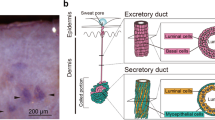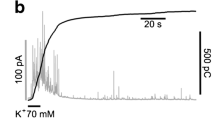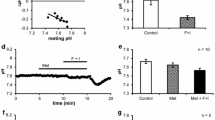Summary
The goal of the present study was to elucidate the ionic mechanisms by which cholinergic stimulation induces cell shrinkage in eccrine clear cells. Dissociated Rhesus monkey eccrine sweat clear cells were prepared by collagenase digestion of freshly isolated secretory coils and immobilized on a glass slide in a perfusion chamber at 30°C. The cell was visualized by light microscopy with differential interference contract (DIC) and was recorded with a video system (15,000× total magnification). The cell volume was calculated from the maximal cross section of the cell. Methacholine (MCh)-induced cell shrinkage, which was as much as 30% of resting cell volume, was dose dependent and pharmacologically specific. MCh-induced cell shrinkage was persistent in some cells but tended to partially wane with time in others. MCh-induced cell shrinkage was dependent on the chemical potential gradient for KCl, i.e., increasing [K] in the bath ([K] o ) from 5 to 120mm caused MCh to induce cell swelling, whereas removing [Cl] o at 120mm K partially restored the MCh-induced cell shrinkage. The interpolated null [K] o (medium [K] where the cell volume did not change by MCh) of 71mm agreed with the predicted [K] o,null. MCh-induced cell shrinkage was inhibited completely by 1mm quinidine (K-channel blocker) and partially by 1mm diphenylamine-2-carboxylic acid (DPC, a Cl-channel blocker), but not by 0.1mm ouabain or 0.1mm bumetanide, suggesting that MCh-induced cell shrinkage may be due to activation of both K and Cl channels with the resultant net KCl efflux down the chemical potential gradient. That Ca/calmodulin may be involved in cholinergic regulation of Cl and K channels is suggested because 10 μm ionomycin also induced cell shrinkage, MCh failed to induce cell shrinkage in a Ca-free medium after the endogenous Ca store was depleted, and (6-aminohexyl)-5-chlorol-naphthalenesulfonamide (W-7, a putative inhibitor of calmodulin) also inhibited MCh-induced cell shrinkage in a reversible manner.
Similar content being viewed by others
References
Chamberlin, M.E., Strange, K. 1989. Anisosmotic cell volume regulation: A comparative view.Am. J. Physiol. 257:C159-C173
Conquer, J., Mahadevappa, V.G. 1990. Inhibition of protein kinase C by H-7 potentiates the release of oleic, linoleic and arachidonic acids in A23187-stimulated human neutrophils.Biochem. Biophys. Res. Commun. 167:168–173
Cook, D.I., Young, J.A. 1989. Fluid and electrolyte secretion by salivary glands.In: Handbook of Physiology. The Gastrointestinal System III. S.G. Schultz and J.G. Forte, editors, pp 1–23. American Physiological Society. Bethesda (MD)
Corcia, A., Armstrong, W.M. 1983. KCl cotransport: A mechanism for basolateral chloride exit inNecturus gallbladder.J. Membrane Biol. 76:173–182
Foskett, J.K., Melvin, J.E. 1989. Activation of salivary secretion: Coupling of cell volume and [Ca2+] i in single cells.Science 24:1582–1585
Geck, P., Heinz, E. 1986. The Na−K−2Cl cotransport system.J. Membrane Biol. 91:97–105
Gögelein, H. 1988. Chloride channels in epithelia.Biochim. Biophys. Acta 947:521–547
Hidaka, H., Tanaka, T. 1983. Naphthalenesulfonamides as calmodulin antagonists.Methods Enzymol. 102:185–194
Izutsu, K., Johnson, D.E. 1986. Changes in elemental concentrations of rat parotid acinar cells following pilocarpine stimulation.J. Physiol. 381:297–309
Lewis, S.A., Donaldson, P. 1990. Ion channels and cell volume regulation: Chaos in an organized system.News Physiol. Sci. 5:112–119
Nakahari, T., Murakami, M., Yoshida, H., Miyamoto, M., Sohma, Y., Imai, Y. 1990. Decrease in rat submandibular acinar cell volume during ACh stimulation.Am. J. Physiol. 258:G878-G886
O'Grady, S.M., Palfrey, H.C., Field, M. 1987. Characteristics and functions of Na−K−Cl cotransport in epithelial tissues.Am. J. Physiol. 253:C177-C192
Reuss L. 1983. Basolateral KCl cotransport in a NaCl-absorbing epithelium.Nature 305:723–726
Reuss, L., Constantin, J.L., Bazile, J.E. 1987. Diphenylamine-2-carboxylate blocks Cl−HCO −3 exchange inNecturus gallbladder epithelium.Am. J. Physiol. 253:C79-C89
Saga, K., Sato, K. 1989. Electron probe X-ray microanalysis of cellular ions in the eccrine secretory coil cells during methacholine stimulation.J. Membrane Biol. 107:13–24
Saga, K., Sato, K., Sato, F. 1988. K+ efflux from monkey eccrine secretory coil during the transient stimulation with agonists.J. Physiol. 405:205–217
Sasaki, S., Nakagaki, I., Mori, H., Imai, Y. 1983. Intracellular calcium store and transport of elements in acinar cells of the salivary gland determined by electron probe x-ray microanalysis.Jpn. J. Physiol. 33:69–83
Sato, K. 1986. Effect of methacholine on ionic permeability of basal membrane of the eccrine secretory cell.Pfluegers Arch.407 (Suppl. 2):S100-S106
Sato, K., Kang, H.W., Saga, K., Sato, K.T. 1989. Biology of the eccrine sweat gland. I: Mechanism of sweat secretion.J. Am. Acad. Dermatol. 20:537–565
Sato, K., Sato, F. 1981. Pharmacologic responsiveness of isolated single eccrine sweat glands.Am. J. Physiol. 240:R44-R51
Sato, K., Sato, F. 1988. Relationship between Quin 2-determined cytosolic [Ca2+] and sweat secretion.Am. J. Physiol. 254:C310-C317
Sato, K., Sato, F. 1989. Characteristics of Na, K, and Cl channels in the clear cell membrane of the eccrine sweat gland as studied by the patch clamp techniques.Clin. Res. 37:369A
Takemura, T., Sato, F., Saga, K., Suzuki, Y., Sato, K. 1991. Intracellular ion concentrations and cell volume during cholinergic stimulation of eccrine secretory coil cells.J. Membrane Biol. 119:211–219
Author information
Authors and Affiliations
Rights and permissions
About this article
Cite this article
Suzuki, Y., Ohtsuyama, M., Samman, G. et al. Ionic basis of methacholine-induced shrinkage of dissociated eccrine clear cells. J. Membrain Biol. 123, 33–41 (1991). https://doi.org/10.1007/BF01993960
Received:
Revised:
Issue Date:
DOI: https://doi.org/10.1007/BF01993960




